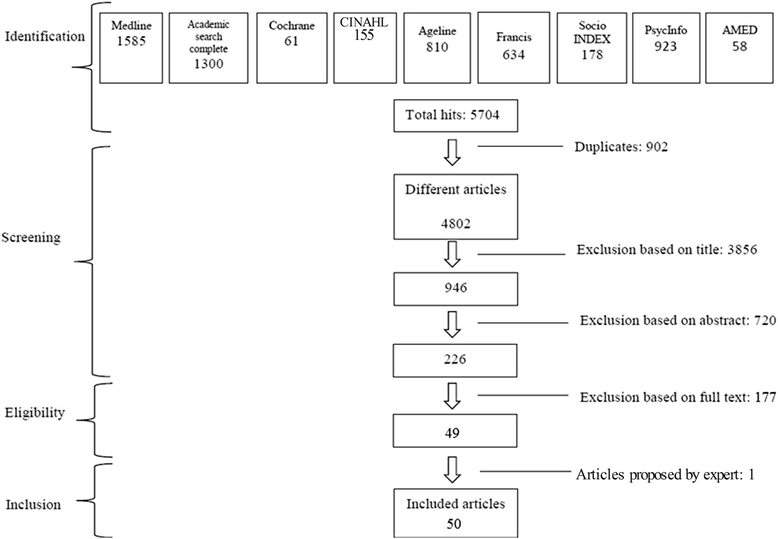Importance of proximity to resources, social support, transportation and neighborhood security for mobility and social participation in older adults: results from a scoping study
- PMID: 26002342
- PMCID: PMC4460861
- DOI: 10.1186/s12889-015-1824-0
Importance of proximity to resources, social support, transportation and neighborhood security for mobility and social participation in older adults: results from a scoping study
Abstract
Background: Since mobility and social participation are key determinants of health and quality of life, it is important to identify factors associated with them. Although several investigations have been conducted on the neighborhood environment, mobility and social participation, there is no clear integration of the results. This study aimed to provide a comprehensive understanding regarding how the neighborhood environment is associated with mobility and social participation in older adults.
Methods: A rigorous methodological scoping study framework was used to search nine databases from different fields with fifty-one keywords. Data were exhaustively analyzed, organized and synthesized according to the International Classification of Functioning, Disability and Health (ICF) by two research assistants following PRISMA guidelines, and results were validated with knowledge users.
Results: The majority of the 50 selected articles report results of cross-sectional studies (29; 58%), mainly conducted in the US (24; 48%) or Canada (15; 30%). Studies mostly focused on neighborhood environment associations with mobility (39; 78%), social participation (19; 38%), and occasionally both (11; 22%). Neighborhood attributes considered were mainly 'Pro ducts and technology' (43; 86) and 'Services, systems and policies' (37; 74%), but also 'Natural and human-made changes' (27; 54%) and 'Support and relationships' (21; 42%). Mobility and social participation were both positively associated with Proximity to resources and recreational facilities, Social support, Having a car or driver's license, Public transportation and Neighborhood security, and negatively associated with Poor user-friendliness of the walking environment and Neighborhood insecurity. Attributes of the neighborhood environment not covered by previous research on mobility and social participation mainly concerned 'Attitudes', and 'Services, systems and policies'.
Conclusion: Results from this comprehensive synthesis of empirical studies on associations of the neighborhood environment with mobility and social participation will ultimately support best practices, decisions and the development of innovative inclusive public health interventions including clear guidelines for the creation of age-supportive environments. To foster mobility and social participation, these interventions must consider Proximity to resources and to recreational facilities, Social support, Transportation, Neighborhood security and User-friendliness of the walking environment. Future studies should include both mobility and social participation, and investigate how they are associated with 'Attitudes', and 'Services, systems and policies' in older adults, including disadvantaged older adults.
Similar articles
-
How to Find Lessons from the Public Health Literature: Example of a Scoping Study Protocol on the Neighborhood Environment.Int J Prev Med. 2016 Jun 20;7:83. doi: 10.4103/2008-7802.184311. eCollection 2016. Int J Prev Med. 2016. PMID: 27413514 Free PMC article.
-
Relationships between the perceived neighborhood social environment and walking for transportation among older adults.Soc Sci Med. 2014 Mar;104:23-30. doi: 10.1016/j.socscimed.2013.12.016. Epub 2013 Dec 18. Soc Sci Med. 2014. PMID: 24581058
-
Social participation in the city: exploring the moderating effect of walkability on the associations between active mobility, neighborhood perceptions, and social activities in urban adults.BMC Public Health. 2023 Dec 7;23(1):2450. doi: 10.1186/s12889-023-17366-0. BMC Public Health. 2023. PMID: 38062419 Free PMC article.
-
The effect of the environment on participation of children and youth with disabilities: a scoping review.Disabil Rehabil. 2013 Sep;35(19):1589-98. doi: 10.3109/09638288.2012.748840. Epub 2013 Jan 25. Disabil Rehabil. 2013. PMID: 23350759
-
Promoting activity participation and well-being among children and adolescents: a systematic review of neighborhood built-environment determinants.JBI Evid Synth. 2020 Mar;18(3):370-458. doi: 10.11124/JBISRIR-D-19-00051. JBI Evid Synth. 2020. PMID: 32197008
Cited by
-
What drives low-income older adults' intention to use mobility applications?Geriatr Gerontol Int. 2024 Mar;24 Suppl 1(Suppl 1):342-350. doi: 10.1111/ggi.14790. Epub 2024 Jan 2. Geriatr Gerontol Int. 2024. PMID: 38169136 Free PMC article.
-
Qualitative exploration of determinants of active mobility and social participation in Urban neighborhoods: individual perceptions over objective factors?Arch Public Health. 2024 Oct 16;82(1):183. doi: 10.1186/s13690-024-01408-z. Arch Public Health. 2024. PMID: 39415295 Free PMC article.
-
County-Level Characteristics Driving Malnutrition Death Rates among Older Adults in Texas.J Nutr Health Aging. 2021;25(7):862-868. doi: 10.1007/s12603-021-1626-2. J Nutr Health Aging. 2021. PMID: 34409963 Free PMC article.
-
The role of functional, social, and mobility dynamics in facilitating older African Americans participation in clinical research.Open Access J Clin Trials. 2017;9:21-30. doi: 10.2147/OAJCT.S122422. Epub 2017 Apr 7. Open Access J Clin Trials. 2017. PMID: 28804246 Free PMC article.
-
What role does social class play in the impact of social environment on residents' health.Sci Rep. 2025 Apr 18;15(1):13430. doi: 10.1038/s41598-025-97525-y. Sci Rep. 2025. PMID: 40251212 Free PMC article.
References
-
- World Health Organization: http://www.who.int/features/factfiles/ageing/ageing_facts/en/ 2014.
-
- Turcotte M, Schellenberg G. A portrait of seniors in Canada 2006. Statistics Canada: Ottawa; 2007.
Publication types
MeSH terms
Grants and funding
LinkOut - more resources
Full Text Sources
Other Literature Sources


